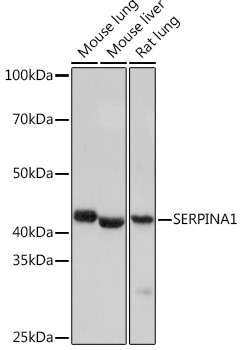Anti-SERPINA1 Antibody (CAB4966)
- SKU:
- CAB4966
- Product type:
- Antibody
- Reactivity:
- Mouse
- Rat
- Host Species:
- Rabbit
- Isotype:
- IgG
- Research Area:
- Immunology
Description
| Antibody Name: | Anti-SERPINA1 Antibody |
| Antibody SKU: | CAB4966 |
| Antibody Size: | 20uL, 50uL, 100uL |
| Application: | WB |
| Reactivity: | Mouse, Rat |
| Host Species: | Rabbit |
| Immunogen: | A synthesized peptide derived from human SERPINA1 |
| Application: | WB |
| Recommended Dilution: | WB 1:500 - 1:2000 |
| Reactivity: | Mouse, Rat |
| Positive Samples: | Mouse lung, Mouse liver, Rat lung |
| Immunogen: | A synthesized peptide derived from human SERPINA1 |
| Purification Method: | Affinity purification |
| Storage Buffer: | Store at -20°C. Avoid freeze / thaw cycles. Buffer: PBS with 0.02% sodium azide, 0.05% BSA, 50% glycerol, pH7.3. |
| Isotype: | IgG |
| Sequence: | Email for sequence |
| Gene ID: | 5265 |
| Uniprot: | P01009 |
| Cellular Location: | |
| Calculated MW: | 51kDa |
| Observed MW: | 45KDa |
| Synonyms: | A1A, A1AT, AAT, PI, PI1, PRO2275, alpha1AT |
| Background: | The protein encoded by this gene is secreted and is a serine protease inhibitor whose targets include elastase, plasmin, thrombin, trypsin, chymotrypsin, and plasminogen activator. Defects in this gene can cause emphysema or liver disease. Several transcript variants encoding the same protein have been found for this gene. [provided by RefSeq, Jul 2008] |
| UniProt Protein Function: | Function: Inhibitor of serine proteases. Its primary target is elastase, but it also has a moderate affinity for plasmin and thrombin. Irreversibly inhibits trypsin, chymotrypsin and plasminogen activator. The aberrant form inhibits insulin-induced NO synthesis in platelets, decreases coagulation time and has proteolytic activity against insulin and plasmin. Ref.17 Ref.18 Ref.24Short peptide from AAT (SPAAT) is a reversible chymotrypsin inhibitor. It also inhibits elastase, but not trypsin. Its major physiological function is the protection of the lower respiratory tract against proteolytic destruction by human leukocyte elastase (HLE). Ref.17 Ref.18 Ref.24 |
| UniProt Protein Details: | Subcellular location: Secreted Ref.24. Short peptide from AAT: Secreted › extracellular space › extracellular matrix Ref.24. Tissue specificity: Plasma. Domain: The reactive center loop (RCL) extends out from the body of the protein and directs binding to the target protease. The protease cleaves the serpin at the reactive site within the RCL, establishing a covalent linkage between the carboxyl group of the serpin reactive site and the serine hydroxyl of the protease. The resulting inactive serpin-protease complex is highly stable. Post-translational modification: Several isomers are observed, resulting from the combination of different N-linked glycan structures and mature N-terminus. N-linked glycan at Asn-107 is alternatively di-antennary, tri-antennary or tetra-antennary, whereas glycan at Asn-70 is di-antennary with trace amounts of tri-antennary, and glycan at Asn-271 is exclusively di-antennary. The structure of the antennas is Neu5Ac(alpha1-6)Gal(beta1-4)GlcNAc attached to the core structure Man(alpha1-6)[Man(alpha1-3)]Man(beta1-4)GlcNAc(beta1-4)GlcNAc. Some antennas are fucosylated, which forms a Lewis-X determinant.Proteolytic processing may yield the truncated form that ranges from Asp-30 to Lys-418. Polymorphism: The sequence shown is that of the M1V allele which is the most common form of PI (44 to 49%). Other frequent alleles are: M1A 20 to 23%; M2 10 to 11%; M3 14 to 19%. Involvement in Disease: Defects in SERPINA1 are the cause of alpha-1-antitrypsin deficiency (A1ATD) [ MIM:613490]. A disorder whose most common manifestation is emphysema, which becomes evident by the third to fourth decade. A less common manifestation of the deficiency is liver disease, which occurs in children and adults, and may result in cirrhosis and liver failure. Environmental factors, particularly cigarette smoking, greatly increase the risk of emphysema at an earlier age. Ref.58 Ref.60 Ref.62 Miscellaneous: The aberrant form is found in the plasma of chronic smokers, and persists after smoking is ceased. It can still be found ten years after smoking has ceased. Sequence similarities: Belongs to the serpin family. Sequence caution: The sequence CAD62334.1 differs from that shown. Reason: Erroneous initiation. Translation N-terminally shortened.The sequence CAD62585.1 differs from that shown. Reason: Erroneous initiation. Translation N-terminally shortened. |
| NCBI Summary: | The protein encoded by this gene is secreted and is a serine protease inhibitor whose targets include elastase, plasmin, thrombin, trypsin, chymotrypsin, and plasminogen activator. Defects in this gene can cause emphysema or liver disease. Several transcript variants encoding the same protein have been found for this gene. [provided by RefSeq] |
| UniProt Code: | P01009 |
| NCBI GenInfo Identifier: | 1703025 |
| NCBI Gene ID: | 5265 |
| NCBI Accession: | P01009.3 |
| UniProt Secondary Accession: | P01009,Q0PVP5, Q13672, Q53XB8, Q5U0M1, Q7M4R2, Q86U18 Q86U19, Q96BF9, Q96ES1, A6PX14, B2RDQ8, |
| UniProt Related Accession: | P01009,Q13747,Q2L9S7,Q3I0J7,Q9P173 |
| Molecular Weight: | 46,737 Da |
| NCBI Full Name: | Alpha-1-antitrypsin |
| NCBI Synonym Full Names: | serpin peptidase inhibitor, clade A (alpha-1 antiproteinase, antitrypsin), member 1 |
| NCBI Official Symbol: | SERPINA1 |
| NCBI Official Synonym Symbols: | PI; A1A; AAT; PI1; A1AT; MGC9222; PRO2275; MGC23330; alpha1AT |
| NCBI Protein Information: | alpha-1-antitrypsin; serpin A1; OTTHUMP00000197150; OTTHUMP00000197151; OTTHUMP00000197152; OTTHUMP00000197153; OTTHUMP00000197154; alpha-1-antiproteinase; alpha-1 protease inhibitor; protease inhibitor 1 (anti-elastase), alpha-1-antitrypsin; serine (or cysteine) proteinase inhibitor, clade A, member 1 |
| UniProt Protein Name: | Alpha-1-antitrypsin |
| UniProt Synonym Protein Names: | Alpha-1 protease inhibitor; Alpha-1-antiproteinase; Serpin A1 |
| Protein Family: | Alpha-1-antitrypsin |
| UniProt Gene Name: | SERPINA1 |
| UniProt Entry Name: | A1AT_HUMAN |




